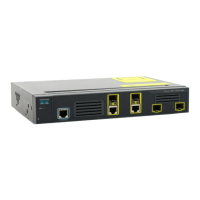Data Sheet
© 2008-2009 Cisco Systems, Inc. All rights reserved. This document is Cisco Public Information. Page 8 of 21
Next-generation Ethernet
access switches for
Metro Ethernet market
●
All-front access provides ease of deployment and troubleshooting in the field.
●
Compact form factor (1 RU x 9.52 in.) allows for deployment in space-limited areas.
●
Dual-speed SFP transceivers support (100BASE and 1000BASE) provides flexible uplink
options.
●
Both AC and DC power options are available.
●
Software is optimized for Metro Ethernet access.
●
Three software feature images help enable support for breadth of services.
●
Software upgrade options allow service providers to purchase only the features needed today
while retaining the option to obtain other features through simple software upgrades.
●
Upgrade options reduce operating expense by lowering the supporting cost for different
products and by reducing the number of different products needed for sparing.
●
METROBASE software feature image is designed for triple-play services.
●
METROACCESS software feature image is designed for premium triple-play services or Layer
2 VPN services.
●
METROIPACCESS software feature image is designed for Layer 3 VPN services.
Service Breadth
Triple-play services
●
Advanced QoS functions provide differentiated class of service treatment to support triple-play
service.
●
Multicast VLAN Registration (MVR) reduces overall bandwidth requirement for multicast
distribution in ring-based networks.
●
Comprehensive security solution protects subscribers, switch, and network at the network
edge.
●
CAT5 and fiber interfaces offer deployment flexibility.
●
Source Specific Multicast (SSM) reduces the need for IP Multicast address management and
prevents DoS attacks against receivers.
●
SSM mapping provides a mapping of source to group, which allows listeners to find/connect
to multicast sources dynamically, reducing dependencies on the application.
Intelligent Ethernet
demarcation
●
Industry standard OAM&P 802.1ag (CFM) feature supports end-to-end network monitoring
and troubleshooting. This reduces operating expense by reducing the site visits needed to
troubleshoot network problems.
●
E-LMI enables service providers to automatically configure the customer-edge device to
match the subscribed service.
●
Ethernet in the First Mile OAM&P (802.3ah) provides support for monitoring, remote failure
indication, loopback, and OAM discovery on the link between the customer equipment and
service provider network.
●
Carrier class redundancy features (Flex-link, RSTP, REP) to support both hub-and-spoke and
ring networks.
Layer 2 VPN service
●
Standard 802.1Q Tunneling creates a hierarchy of 802.1Q tags, helping service providers use
a single VLAN to support customers who have multiple VLANs while preserving customer
VLAN IDs and segregating traffic from different customers within the service provider
infrastructure.
●
L2PT allows for transport of the customers’ control protocols, thereby allowing for a true
virtual-circuit service across service providers’ shared infrastructure.
Layer 3 VPN service
●
Multi-VRF CE (VRF-lite) forms virtual packet-forwarding tables by associating one or more
Layer 3 interfaces with each VRF, allowing the creation of multiple Layer 3 VPNs on a single
Cisco ME 3400 Series Switch. Interfaces in a VRF could be either physical, as in an Ethernet
port, or logical, as in a VLAN switch virtual interface (SVI), requiring the METROIPACCESS
feature image.
●
IP Multicast support in Multi-VRF CE allows customers to migrate to VRF-lite without affecting
application and services that depend on IP Multicast.
●
VRF-aware services (ARP, Ping, SNMP, HSRP, uRPF Syslog, Traceroute, FTP, and TFTP)
help in managing individual VRFs.
●
Support for multiple IP routing protocols (RIPv1/v2, EIGRP, OSPF, IS-IS, and BGPv4) offers
flexible options for peering between customers and service providers.

